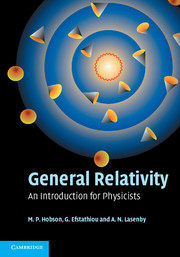Book contents
- Frontmatter
- Contents
- Preface
- 1 The spacetime of special relativity
- 2 Manifolds and coordinates
- 3 Vector calculus on manifolds
- 4 Tensor calculus on manifolds
- 5 Special relativity revisited
- 6 Electromagnetism
- 7 The equivalence principle and spacetime curvature
- 8 The gravitational field equations
- 9 The Schwarzschild geometry
- 10 Experimental tests of general relativity
- 11 Schwarzschild black holes
- 12 Further spherically symmetric geometries
- 13 The Kerr geometry
- 14 The Friedmann–Robertson–Walker geometry
- 15 Cosmological models
- 16 Inflationary cosmology
- 17 Linearised general relativity
- 18 Gravitational waves
- 19 A variational approach to general relativity
- Bibliography
- Index
14 - The Friedmann–Robertson–Walker geometry
Published online by Cambridge University Press: 05 September 2012
- Frontmatter
- Contents
- Preface
- 1 The spacetime of special relativity
- 2 Manifolds and coordinates
- 3 Vector calculus on manifolds
- 4 Tensor calculus on manifolds
- 5 Special relativity revisited
- 6 Electromagnetism
- 7 The equivalence principle and spacetime curvature
- 8 The gravitational field equations
- 9 The Schwarzschild geometry
- 10 Experimental tests of general relativity
- 11 Schwarzschild black holes
- 12 Further spherically symmetric geometries
- 13 The Kerr geometry
- 14 The Friedmann–Robertson–Walker geometry
- 15 Cosmological models
- 16 Inflationary cosmology
- 17 Linearised general relativity
- 18 Gravitational waves
- 19 A variational approach to general relativity
- Bibliography
- Index
Summary
We now discuss the application of general relativity to modelling the behaviour of the universe as a whole. In order to do this, we make some far-reaching assumptions, but only those consistent with our observations of the universe. As in our derivations of the Schwarzschild and Kerr geometries, we begin by using symmetry arguments to restrict the possible forms for the metric describing the overall spacetime geometry of the universe.
The cosmological principle
When we look up at the sky we see that the stars around us are grouped into a large-density concentration – the Milky Way Galaxy. On a slightly larger scale, we see that our Galaxy belongs to a small group of galaxies (called the Local Group). Our Galaxy and our nearest large neighbour, the Andromeda galaxy, dominate the mass of the Local Group. On still larger scales we see that our Local Group sits on the outskirts of a giant supercluster of galaxies centred in the constellation of Virgo. Evidently, on small scales matter is distributed in a highly irregular way but, as we look on larger and larger scales, the matter distribution looks more and more uniform. In fact, we have very good evidence (particularly from the constancy of the temperature of the cosmic microwave background in different directions on the sky) that the universe is isotropic on the very largest scales, to high accuracy.
- Type
- Chapter
- Information
- General RelativityAn Introduction for Physicists, pp. 355 - 385Publisher: Cambridge University PressPrint publication year: 2006
- 1
- Cited by



